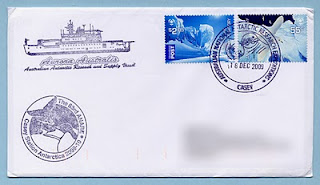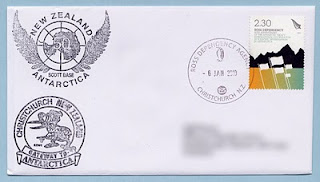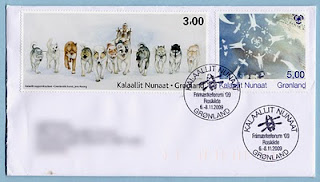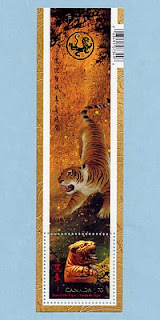
Friday, January 22, 2010
AAT Casey Station Cover 2009
This cover came back to me recently from Casey Station in the Australian Antarctic Territory. The Aurora Australis arrived at Casey on 18 Dec 2009 (8AM), the same day the cover was cancelled. I’m guessing the cover came back on a plane from Casey as this station is serviced by a number of flights that use the nearby Wilkins Runway. ANARE stands for Australian National Antarctic Research Expeditions which have been ongoing since 1947, making 2010 the 63rd year of Australian research expeditions in the Antarctic.


Sunday, January 17, 2010
Amundsen-Scott South Pole Station Cover
Received this cover back from the US Amundsen-Scott South Pole Station a short while ago. The South Pole station is within a short distance of the actual south pole. The ice drifts a bit so the exact location of the base is always changing. Originally the base consisted of a large dome under which was housed most of the bases facilities. But a new base was finished in 2003. The last remnants of the old dome have just been removed (Jan 2010). Some images of the destruction of the dome and construction of the new base can be found here.


Project Ice Cube is a "device" to detect muon particles. Muons are the result of neutrino collisions with other particles which apparently is an extremely rare event. It’s essentially a detection array that consists of several holes drilled into an area of pure clear ice with stings of sensors placed place down the holes. These holes are 2.5km deep although the array only occupies the bottom kilometer. When muon particles are born they produce a flash of blue light which the sensors in the ice detect. From the data gathered, the direction of travel of the original neutrino that created the muon can be determined which should point back to the source of emission.
The address I used to get my cover to the base was "Postmaster, South Pole Station, PSC 468 Box 400, APO AP 96598, United States". Being an APO means it's just like sending and receiving mail to the US.


Project Ice Cube is a "device" to detect muon particles. Muons are the result of neutrino collisions with other particles which apparently is an extremely rare event. It’s essentially a detection array that consists of several holes drilled into an area of pure clear ice with stings of sensors placed place down the holes. These holes are 2.5km deep although the array only occupies the bottom kilometer. When muon particles are born they produce a flash of blue light which the sensors in the ice detect. From the data gathered, the direction of travel of the original neutrino that created the muon can be determined which should point back to the source of emission.
The address I used to get my cover to the base was "Postmaster, South Pole Station, PSC 468 Box 400, APO AP 96598, United States". Being an APO means it's just like sending and receiving mail to the US.
Friday, January 15, 2010
Ross Dependency Cover
This is a cover I received back from the Ross Dependency the other day. I sent it down there around the end of November and it came back in fairly quick time considering the time of year. It was also wrapped in plastic so it came though the postal system nice and fresh.

Although the cover includes what appears to be a 50th anniversary cachet on it, it's likely this was a cachet produced for the 50th anniversary of the New Zealand Antarctic program which was back in 2006, and not the 50th anniversary of the Antarctic Treaty which was Dec of 2009 and commemorated on the stamp on this cover.
Mail hasn't been processed at the Scott Base on the continent since 1987. All mail to and from the base is handled by the Dependency post office in Christchurch New Zealand, hence the Christchurch cancel on this cover.

Although the cover includes what appears to be a 50th anniversary cachet on it, it's likely this was a cachet produced for the 50th anniversary of the New Zealand Antarctic program which was back in 2006, and not the 50th anniversary of the Antarctic Treaty which was Dec of 2009 and commemorated on the stamp on this cover.
Mail hasn't been processed at the Scott Base on the continent since 1987. All mail to and from the base is handled by the Dependency post office in Christchurch New Zealand, hence the Christchurch cancel on this cover.
Sunday, January 10, 2010
Covers from Greenland
Received this cover the other day from the Philatelic Center in Tasiilaq, Greenland. It was cancelled at "Frimærkeforum 2009" in Roskilde Denmark, back on 8 Novemebr 2009. Took a surprisingly long time to get back here but was in pretty good shape.

I used a 3.00 DKK stamps from the first "Contemporary Art" series issued in May of 2007. This stamp was designed by Jens Rosing: a renowned and much loved Greenlandic artist who designed more than 130 stamps for Greenland. And this stamp is that largest (in size) ever issued by Greenland. But what is more important about this stamp is that it was the last one Jens did for Greenland before his death in May 2008.

His daughter Ina is also an artist and one of her designs was used in the second Greenland Contemporary Art series. I put these two stamps on another cover that I sent to Upernavik for cancellation. At the time I did not realize who had designed these two stamps but if I had recognized the connection and significance sooner I might have prepared more covers with these beautiful stamps on them.

I used a 3.00 DKK stamps from the first "Contemporary Art" series issued in May of 2007. This stamp was designed by Jens Rosing: a renowned and much loved Greenlandic artist who designed more than 130 stamps for Greenland. And this stamp is that largest (in size) ever issued by Greenland. But what is more important about this stamp is that it was the last one Jens did for Greenland before his death in May 2008.

His daughter Ina is also an artist and one of her designs was used in the second Greenland Contemporary Art series. I put these two stamps on another cover that I sent to Upernavik for cancellation. At the time I did not realize who had designed these two stamps but if I had recognized the connection and significance sooner I might have prepared more covers with these beautiful stamps on them.
Saturday, January 9, 2010
Canada Lunar New Year 2010: Year of the Tiger
Canada Post issued its second in the new Lunar New Year series on 8 Jan 2009. This year is the year of the Tiger. As with the previous series and this one, a domestic “Permanent” rate stamp was issued in sheets of 25 and an international rate stamp was issued in souvenir sheet format. These stamps reflect the 2010 postal rate increase in Canada with domestic rates changing from $0.54 to $0.57 and international rates from $1.65 to $1.70. As with last years “Ox” souvenir sheet, the image on the stamp is heavily embossed. On the Tiger sheet the lettering and some other accents have been printed in gold foil. I think it’s an improvement over last years “Ox” stamp issues and the design is certainly much more complex than the previous series “Tiger” issue.


Friday, January 1, 2010
India Post's Preserve the Polar Regions and Glaciers Issue
Happy New Year!
I see that India Post has finally put up images of their "Preserve the Polar Regions and Glaciers" stamps that they issued on 19 December 2009.


I wouldn't be surprised if we see another late addition to the PPRG series sometime in 2010.
I see that India Post has finally put up images of their "Preserve the Polar Regions and Glaciers" stamps that they issued on 19 December 2009.
I wouldn't be surprised if we see another late addition to the PPRG series sometime in 2010.
Subscribe to:
Posts (Atom)